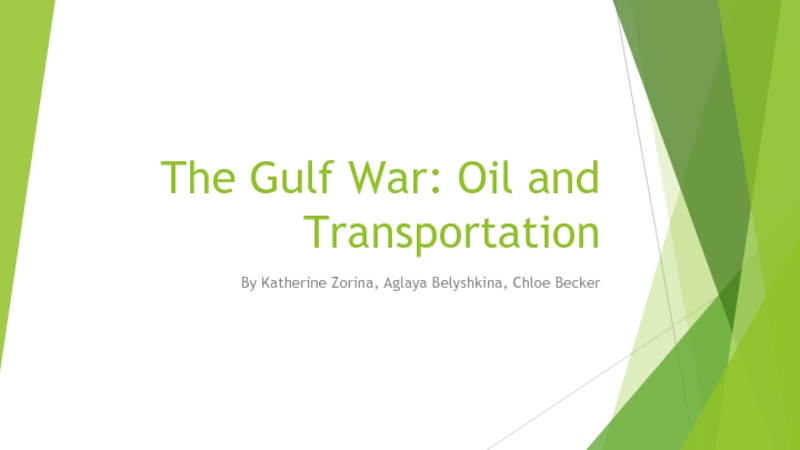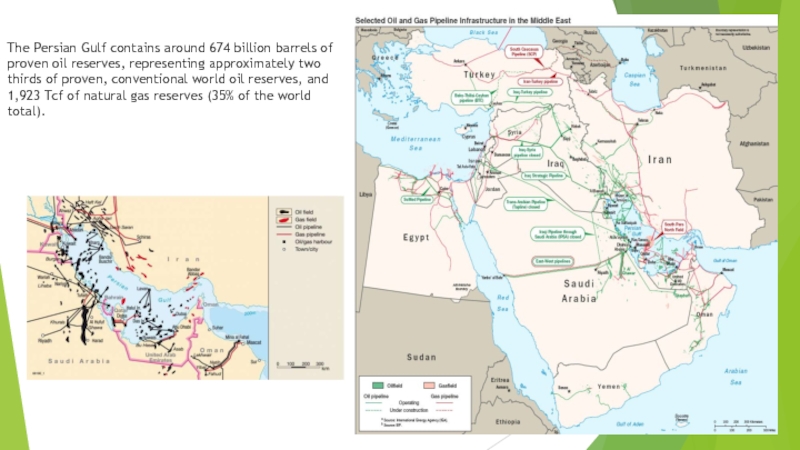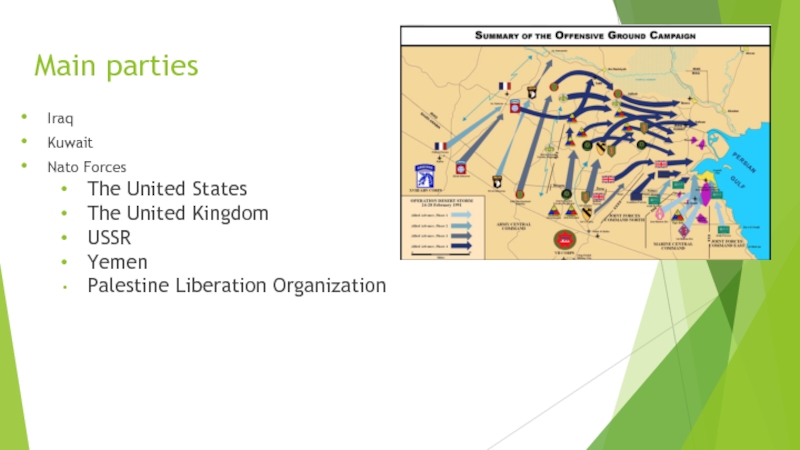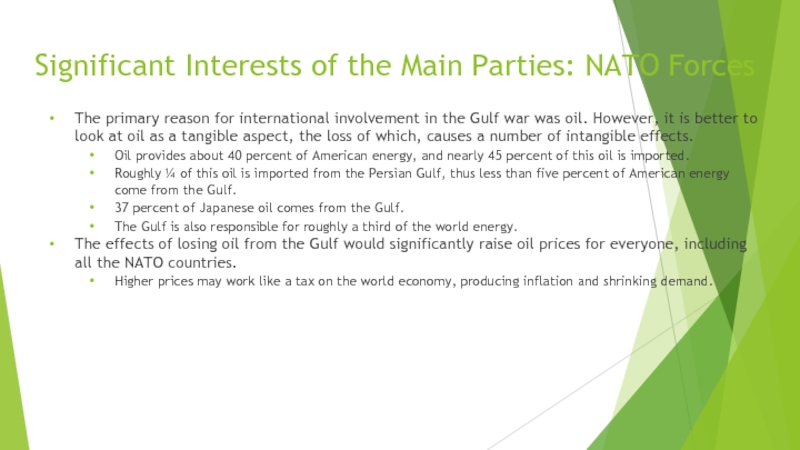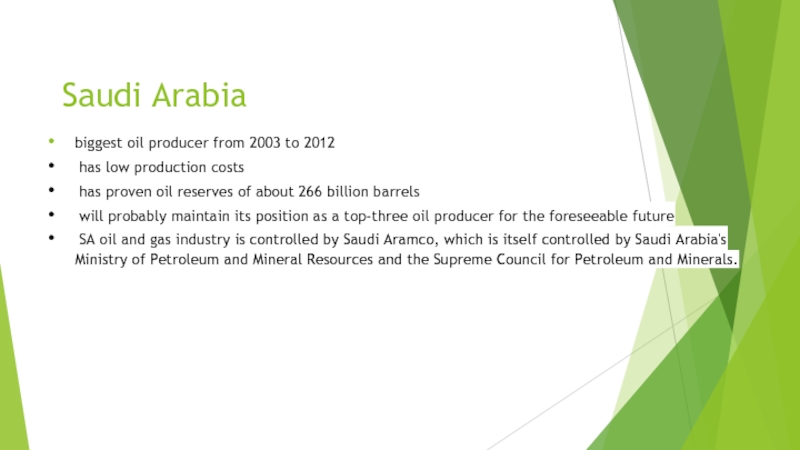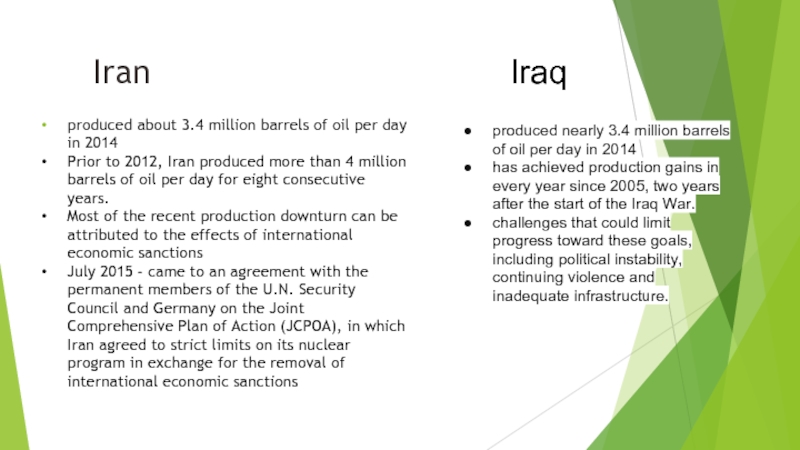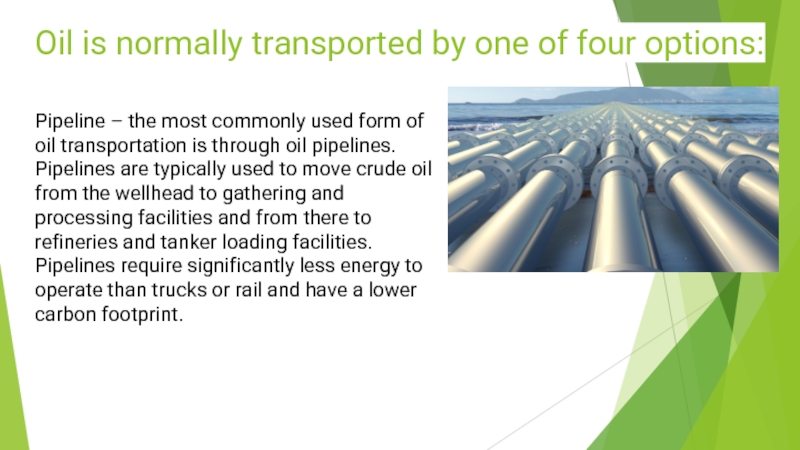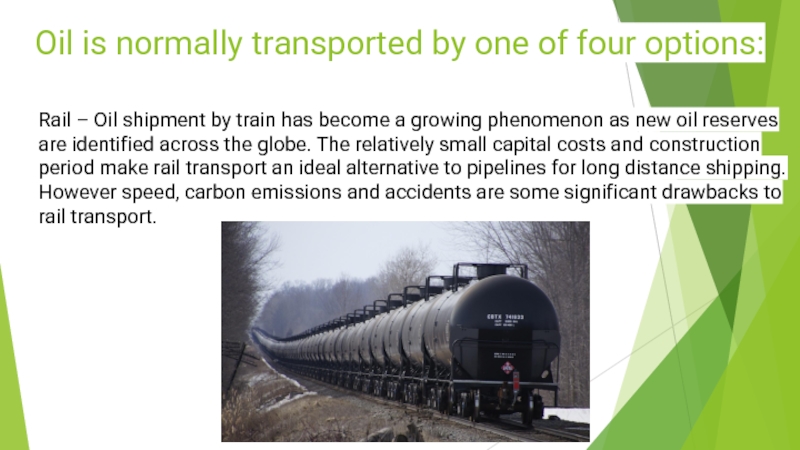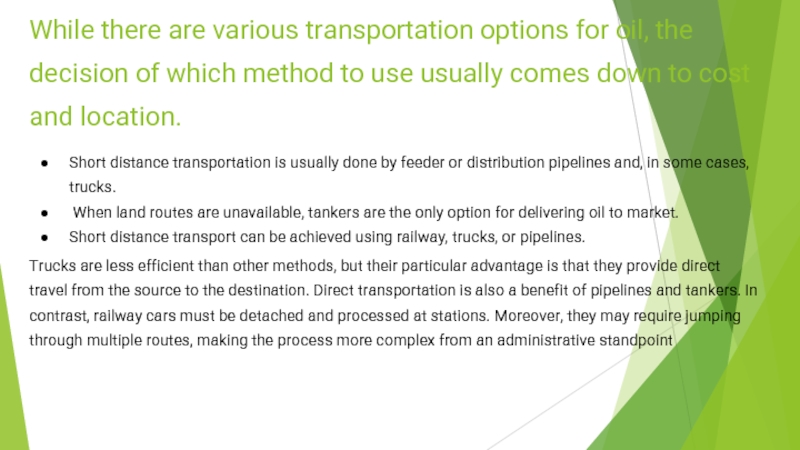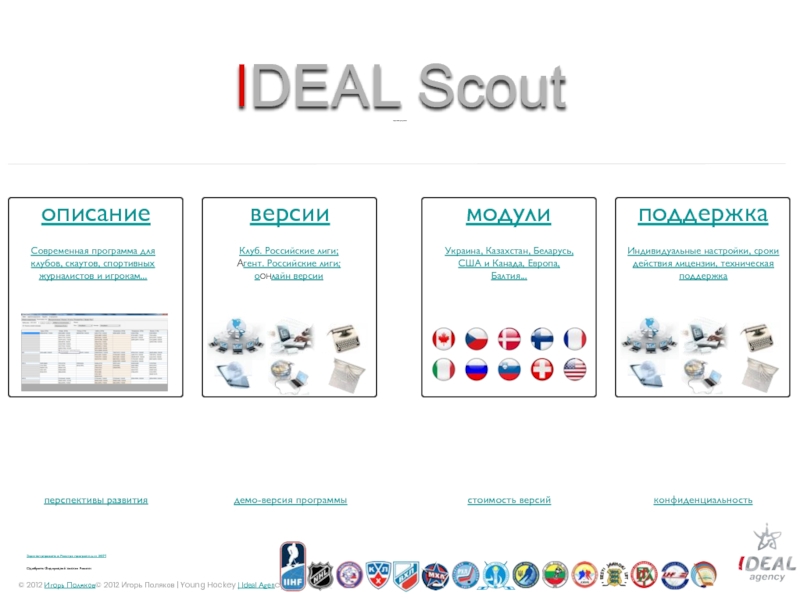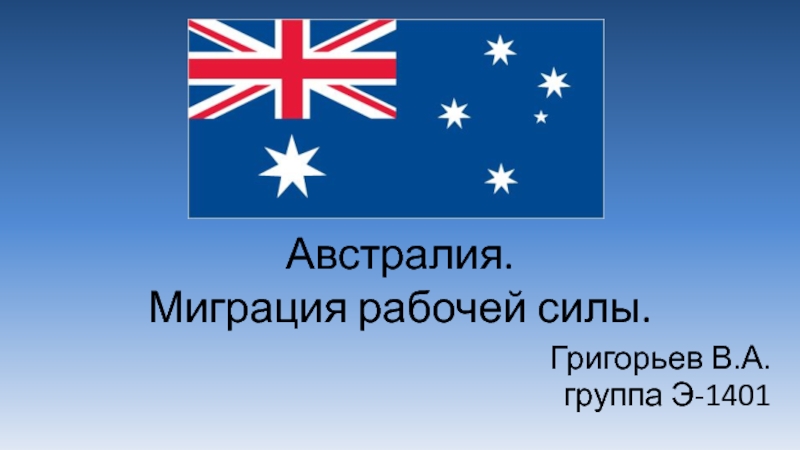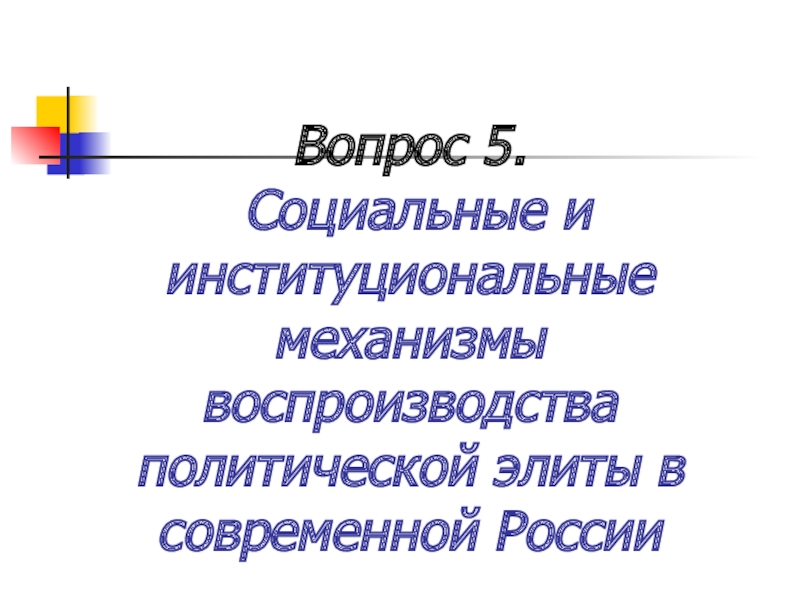- Главная
- Разное
- Дизайн
- Бизнес и предпринимательство
- Аналитика
- Образование
- Развлечения
- Красота и здоровье
- Финансы
- Государство
- Путешествия
- Спорт
- Недвижимость
- Армия
- Графика
- Культурология
- Еда и кулинария
- Лингвистика
- Английский язык
- Астрономия
- Алгебра
- Биология
- География
- Детские презентации
- Информатика
- История
- Литература
- Маркетинг
- Математика
- Медицина
- Менеджмент
- Музыка
- МХК
- Немецкий язык
- ОБЖ
- Обществознание
- Окружающий мир
- Педагогика
- Русский язык
- Технология
- Физика
- Философия
- Химия
- Шаблоны, картинки для презентаций
- Экология
- Экономика
- Юриспруденция
The gulf war. Oil and transportation презентация
Содержание
- 1. The gulf war. Oil and transportation
- 2. The Persian Gulf contains around
- 3. Background of the Conflict The Gulf
- 4. Geography - Geoeconomics - Geopolitics Geographical
- 5. Main parties Iraq Kuwait
- 6. Significant Interests of the Main Parties: NATO
- 7. Saudi Arabia biggest oil producer from 2003
- 8. Iran produced about 3.4 million barrels
- 9. United Arab Emirates produced nearly 3.5
- 10. Kuwait produced almost 2.8 million barrels
- 11. OIL TRANSPORTATION Getting oil to market
- 12. Oil is normally transported by one of
- 13. Oil is normally transported by one of
- 14. Oil is normally transported by one of
- 15. Oil is normally transported by one of
- 16. While there are various transportation options for
- 17. An important issue that oil transportation
- 18. References History.com Staff. “Persian Gulf War.”
Слайд 2
The Persian Gulf contains around 674 billion barrels of proven oil
Слайд 3Background of the Conflict
The Gulf War, which began on August
The conflict began when Iraq’s leader Saddam Hussein delivered a speech, in 1990, accusing Kuwait of stealing crude oil from the Rumaila Oil Field which run along their shared border. Hussein demanded that Kuwait and Saudi Arabia reimburse $30 billion of Iraq’s debt; furthermore, he insisted Kuwait and Saudi Arabia conspired to lower oil prices in exchange for favors of western nations.
Following the speech, Iraq began building troops at Kuwait’s border. On August 2nd, 1990 Hussein ordered the invasion of Kuwait.
In response, 2/3rds of the 21 members of the Arab League criticized Iraq’s actions and turned to members of NATO for help.
Слайд 4Geography - Geoeconomics - Geopolitics
Geographical Position
The Rumaila Oil Field is
Geoeconomical Significance
It is believed that the field contains 17 billion barrel of crude oil and accounts for roughly 12 percent of Iraq’s oil reserves.
Geopolitical Significance
Due to the close proximity of Kuwait and Iraq, Iraq was able to accuse Kuwait of stealing crude oil. Much of the world is dependent on oil from the Gulf. Thus, if Hussein were to raise oil prices, there would be mass effects on the world economy.
Слайд 5Main parties
Iraq
Kuwait
Nato Forces
The United States
The United
USSR
Yemen
Palestine Liberation Organization
Слайд 6Significant Interests of the Main Parties: NATO Forces
The primary reason
Oil provides about 40 percent of American energy, and nearly 45 percent of this oil is imported.
Roughly ¼ of this oil is imported from the Persian Gulf, thus less than five percent of American energy come from the Gulf.
37 percent of Japanese oil comes from the Gulf.
The Gulf is also responsible for roughly a third of the world energy.
The effects of losing oil from the Gulf would significantly raise oil prices for everyone, including all the NATO countries.
Higher prices may work like a tax on the world economy, producing inflation and shrinking demand.
Слайд 7Saudi Arabia
biggest oil producer from 2003 to 2012
has low production
has proven oil reserves of about 266 billion barrels
will probably maintain its position as a top-three oil producer for the foreseeable future
SA oil and gas industry is controlled by Saudi Aramco, which is itself controlled by Saudi Arabia's Ministry of Petroleum and Mineral Resources and the Supreme Council for Petroleum and Minerals.
Слайд 8Iran
produced about 3.4 million barrels of oil per day in 2014
Prior
Most of the recent production downturn can be attributed to the effects of international economic sanctions
July 2015 - came to an agreement with the permanent members of the U.N. Security Council and Germany on the Joint Comprehensive Plan of Action (JCPOA), in which Iran agreed to strict limits on its nuclear program in exchange for the removal of international economic sanctions
Iraq
produced nearly 3.4 million barrels of oil per day in 2014
has achieved production gains in every year since 2005, two years after the start of the Iraq War.
challenges that could limit progress toward these goals, including political instability, continuing violence and inadequate infrastructure.
Слайд 9United Arab Emirates
produced nearly 3.5 million barrels of oil per day
The state-owned Abu Dhabi National Oil Company (ADNOC) controls oil production operations in Abu Dhabi under the direction of the emirate's Supreme Petroleum Council.
companies, which are involved in oil production: BP plc, Royal Dutch Shell plc, Total S.A. and Exxon Mobil Corporation.
Слайд 10Kuwait
produced almost 2.8 million barrels of oil per day in
International oil companies have long been denied access to Kuwait because the Kuwaiti constitution does not allow foreign companies ownership stakes in Kuwaiti natural resources, or the revenues associated with those resources
Слайд 11OIL TRANSPORTATION
Getting oil to market is a process that requires various
Слайд 12Oil is normally transported by one of four options:
Pipeline – the
Слайд 13Oil is normally transported by one of four options:
Rail – Oil
Слайд 14Oil is normally transported by one of four options:
Truck – while
Слайд 15Oil is normally transported by one of four options:
Ship – where
Слайд 16While there are various transportation options for oil, the decision of
Short distance transportation is usually done by feeder or distribution pipelines and, in some cases, trucks.
When land routes are unavailable, tankers are the only option for delivering oil to market.
Short distance transport can be achieved using railway, trucks, or pipelines.
Trucks are less efficient than other methods, but their particular advantage is that they provide direct travel from the source to the destination. Direct transportation is also a benefit of pipelines and tankers. In contrast, railway cars must be detached and processed at stations. Moreover, they may require jumping through multiple routes, making the process more complex from an administrative standpoint
Слайд 17
An important issue that oil transportation and storage methods face are
Слайд 18References
History.com Staff. “Persian Gulf War.” History.com, A&E Television Networks, 2009,
www.history.com/topics/persian-gulf-war.
https://www.theodora.com/pipelines/middle_east_oil_gas_products_pipelines_map.htm
http://www.persiangulfonline.org/en/persian-gulf-oil-and-gas-exports-fact-sheet-u-s-department-of-energy/l
https://www.investopedia.com/articles/investing/101515/biggest-oil-producers-middle-east.asp
